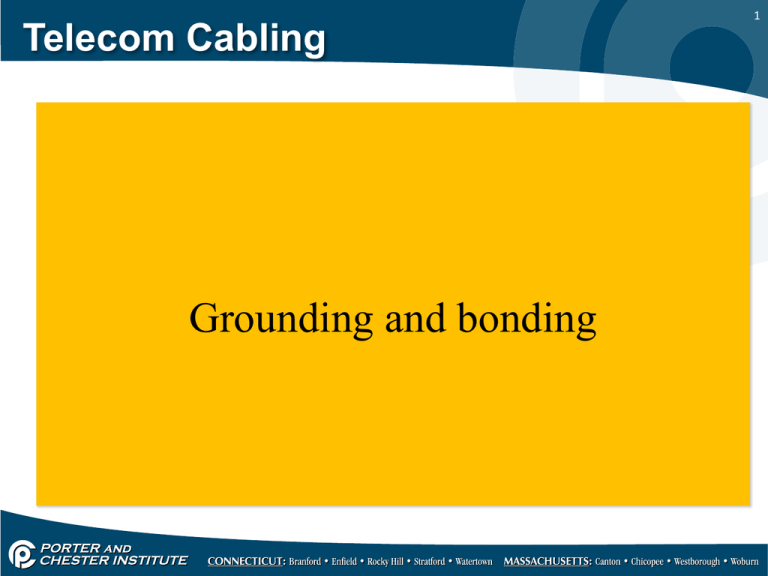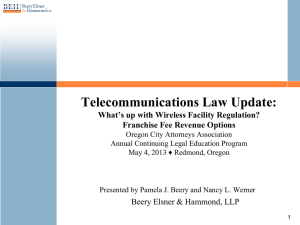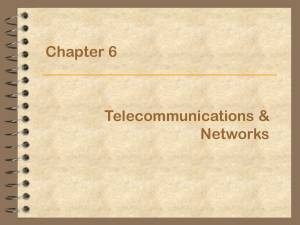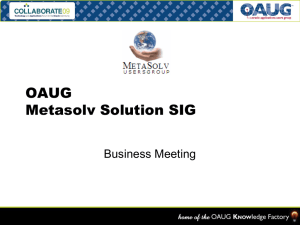Telecom Cabling
advertisement

1 Telecom Cabling Grounding and bonding 2 Telecom Cabling We’re going to take a look at the grounding and bonding requirement for our TRs and entrance facilities EFs. Grounding and bonding is covered in the NEC in article 250 and is also covered in TIA/EIA 607. Standard 607 essentially follows article 250 of the code however you will be introduced to some new terminology and methods taken from the 607 standard. 3 Telecom Cabling Whenever we talk about grounding it is in reference to earth, where as bonding is an electrical connection that provides a path to earth. Per NEC a ground is: A conducting connection, whether intentional or accidental, between an electrical circuit or equipment and the earth or to some conducting body that serves in place of the earth. 4 Telecom Cabling Per NEC bonding is: The permanent joining of metallic parts to form an electrically conductive path that ensures electrical continuity and the capacity to conduct safely any current likely to be imposed. The symbols for grounding are: 5 Telecom Cabling Per TIA/EIA 607: TMGB: Telecommunications main grounding bus bar TGB: Telecommunication grounding bus bar TBB: Telecommunications bonding backbone TBBIBC: Telecommunications bonding backbone interconnecting bonding conductor 6 Telecom Cabling The ANSI/EIA/TIA-607 standard defines a telecommunications grounding and bonding system and the interconnections to the building electrical grounding system. The recommendations made in the standards do not supersede the bonding and grounding requirements of national and local electrical code. 7 Telecom Cabling The system begins at the electrical service entrance, travels to the TMGB and continues through to each TGB located in individual telecommunications closets on each floor of the building structure, finally looping back around to the original TMGB. 8 Telecom Cabling Here is the TMGB, TGB and TBB grounding system. 9 Telecom Cabling The ANSI/EIA/TIA-607 standard requires that all communications bonding conductors be listed for the intended purpose and approved by a nationally recognized testing laboratory such as UL or ETL. Bonding conductors must always be insulated wires. 10 Telecom Cabling The standard also requires that bonding conductors be made of copper, other metal types are not supported for use as a bonding conductor by the ANSI/EIA/TIA-607 standard. In addition, the minimum size of all bonding conductors must be at least a #6 AWG wire. 11 Telecom Cabling The ANSI/EIA-TIA-607 standard prohibits placing bonding conductors in a metallic conduit made of iron. This standard requires that if the bonding conductor must be placed in an iron conduit longer than 1m (3 ft.) in length, then bonding conductor must be bonded at each end of the conduit. The wires used for bonding the bonding conductor must be at least a #6 AWG wire. 12 Telecom Cabling Connections to the TMGB or lugs should be exothermic welds. Exothermic welds provide a connection that helps ensure the long-term integrity of the grounding system. 13 Telecom Cabling The TBBIBC would also be used to bond two or more TGBs installed in the same TR together. The TBBIBC is also used to bond the TGBs installed in different TRs that reside on the same floor of the building. This connection would follow the same requirements as bonding multiple TBBs at the top floor and a minimum of every third floor. 14 Telecom Cabling The ANSI/EIA/TIA-607 standard requires that when two or more TBBs are installed vertically in the intra-building backbone pathway, the TBBs must be bonded together. The telecommunications bonding backbone interconnecting bonding conductor (TBBIBC) is the component used for this function (see the figure below). 15 Telecom Cabling The ANSI/EIA/TIA-607 standard requires that the TBBIBC be installed at the top floor and a minimum of every third floor. The minimum size of the TBBIBC must be no smaller than the TBB conductor size. 16 Telecom Cabling Telecommunications grounding and bonding is additional grounding and bonding installed specifically for telecommunications. This is not a replacement for grounding and bonding specified by the National Electrical Code (NEC) but typically is additional to address telecommunications system performance. 17 Telecom Cabling The images below are grounding/bonding bus bars, notice that they’re made of ¼” thick copper plates and are pre drilled with a variety of different holes and also have insulated mounting brackets. 18 Telecom Cabling The TGMB located in the entrance facility or MDF is normally a much larger universal grounding bus bar than the TGB. All connections between the TGMB and the TGB must be installed with what size ground wire? 19 Telecom Cabling How do we identify a ground wires of sizes 6 gauge or smaller? 20 Telecom Cabling An insulated grounded conductor of 6 AWG or smaller shall be identified by a continuous white or gray outer finish or… By three continuous white stripes along its entire length on other than green insulation. This means that a green insulated conductor is also acceptable as a grounding conductor. 21 Telecom Cabling NEC article 250.8: Connection devices or fittings that depend solely on solder shall not be used. Why should we not solder a ground connection? 22 Telecom Cabling Notice that grounding and bonding connections made to the TGB are done with electrical wire connectors and a bolt and nut are used to make the connection. 23 Telecom Cabling All ground connections per the NEC shall be as short and straight as practicable, this means soft bends and no sharp 90 degree bends. 24 Telecom Cabling The next slide will show a fully compliant grounding system in a TR. Take a few minutes to see all of the connections and gauge sizes used for bonding. You will notice the term future growth used we mentioned future growth in a previous lecture. 25 Telecom Cabling 26 Telecom Cabling Here are some other listed grounding/bonding clamps. Pipe clamp Cable tray bonding strap Acorn clamp for ground rods CATV ground block Telecom pipe strap Small grounding bus bar 27 Telecom Cabling All ground clamps are listed for a specific conductor size and whether or not they can be used for a single connection or multiple connections. Ground clamps are also listed for direct burial use, direct buried clamps are coated for protection against corrosion. The best possible ground connection is an exothermic weld. 28 Telecom Cabling The grounding electrode system shall have a resistance of 25 ohms or less. If the grounding electrode system is not 25 ohms or less than it shall be augmented with an additional grounding electrode. If two grounding electrodes are used they shall be no less than 6’ apart and shall be bonded together with a 6 AWG ground wire. 29 Telecom Cabling The grounding conductor can be stranded or solid. The minimum allowable ground wire size is a 14 gauge and is typically used only in residential dwellings and in one and two family dwellings shall not be longer than 20 feet. 30 Telecom Cabling ¾” conduit can be used as a ground rod, article 250.52 (5). Rod and pipe electrodes shall be installed such that at least 8’ of length is in direct contact with the earth. If rock bottom is encountered than the rod shall be driven at an angle up to 45 degrees, if it can’t be driven in at 45 degrees it shall permitted to be buried in a trench no less than 30 inches deep. 31 Telecom Cabling The AHJ will inspect the grounding electrode system when he is on site and will want to see that all racks are bonded. The grounding electrode system on construction projects is typically installed by the electricians and the low voltage technician bonds all of his equipment in all of the TRs on the site to the installed grounding electrode system.











